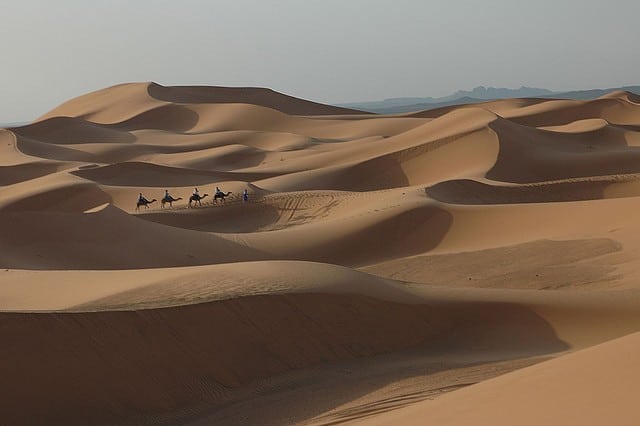The term Sahara in Arabic literally means simply “desert.” The Sahara Desert, which today, spreads over 3.3 million square miles has continued to mesmerize tourists for centuries. Covering around 25 percent of Africa, Sahara Desert is world’s hottest desert. Touching 12 African nations, including Egypt, Chad, Algeria, Eritrea, Libya, Morocco, Niger, Mauritania, Mali, Sudan, Western Sahara, and Tunisia, it also happens to be the third largest desert after Antarctica and the Arctic deserts.
The desert starts at the Red Sea, spreads across the Mediterranean, and finally to the Atlantic Ocean. If we turn the pages of history all the world over, we find evidences to the fact that Sahara Desert served as the world’s first gateway to Africa.
The Sahara is divided into western Sahara, the central Ahaggar Mountains, the Tibesti Mountains, the Aïr Mountains , Ténéré desert and the Libyan Desert. However, due to the harsh climatic conditions of the desert where the temperature crosses the fifty degree mark, it is one of the planet’s lowest population densities area.
Unlike the popular imagination of desert being dotted with sand dunes, most of the Sahara is characterized as rocky hamada, characterized by primarily barren, hard, rocky plateaus. But that doesn’t mean that there are no sand dunes in the area. In fact, some of the sand dunes in Sahara Desert can reach approximately 590 feet in height.
As far as the climate of Sahara Desert is concerned, being the hottest desert of the world, temperatures here tend to reach as high as 57.7 degrees. In fact, its scorching heat and cycle of rainfall highly influences the sub-Saharan Africa. Torrential, hurricane like winds resulting in sand storms and dust devils are prevalent in the area. The annual precipitation that the area receives is not more than 4 inches. However, the infrequent rain is usually torrential. Thus, travel enthusiasts recommend that the best time to visit Sahara is between the months of October and April. Even early May is a good time as during this period, the daytime temperatures are generally bearable.
The Sahara Desert is considered a haven for both wildlife enthusiasts and photographers. In fact, camels, scorpions, monitor lizards, sand vipers, wild dogs and ostriches are the common fauna found in Sahara Desert. Among the rare birds, African Silver Bills and Black-throated Firefinch are found here.
When visiting Sahara Desert, tourists should keep a few things in mind. Since the temperatures are very high in the region, visitors are advised to wear light clothes to tolerate the scorching heat. Also, it is highly recommended that you carry sunglasses or a hat to further add to your protection. Carry a bottle of water always to maintain your fluid levels and keep yourself hydrated. Also, deserts tend to get chilly at night. So if you intend to spend a night at one of the campsites, ensure that you carry a shawl or light woolens along for the night.
As far as accessing Sahara Desert is concerned, as mentioned before, there are twelve countries over which the desert is spread. So, travelers can access the desert from any of these countries. Some good options for first time Saharan travel are:
• Morocco: Renowned as the most accessible slice of the Sahara, Drâa Valley and Merzouga are the major highlights of this stretch.
• Egypt: Oases of Al-Kharga, Dakhla, Farafra and Bahariya are the reputed tourist hotspots in this area.
• Tunisia: Celebrated for its cinematic beauty, this is also among the most frequented stretch of the Saharan desert.
So for a breathtaking experience of a desert, witness the Sahara desert!













